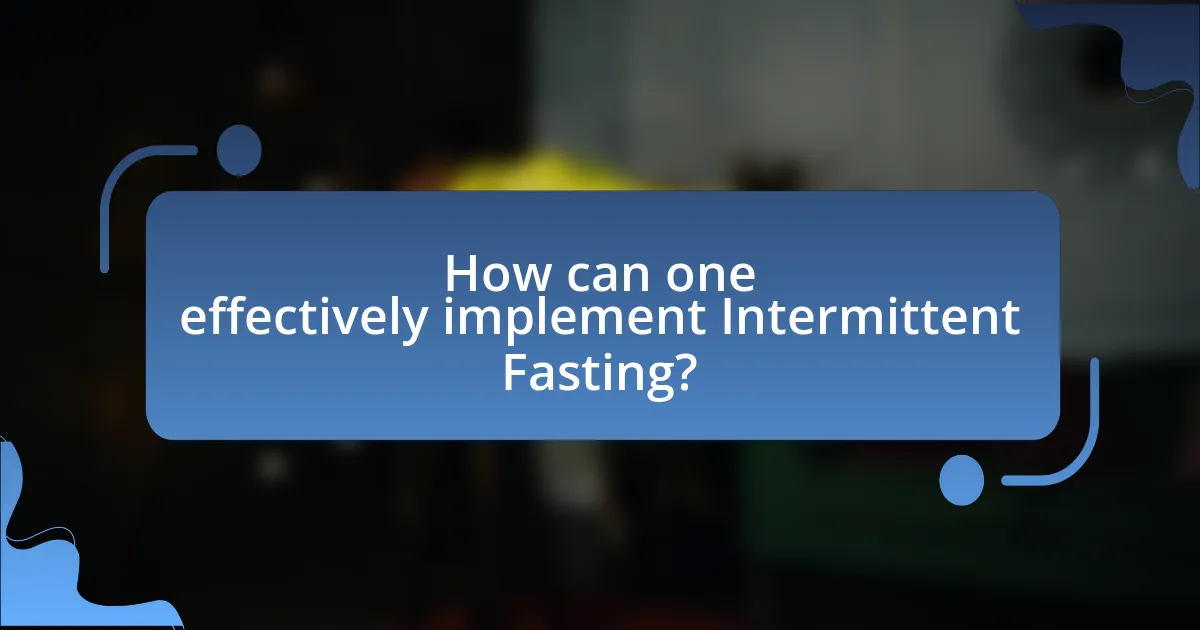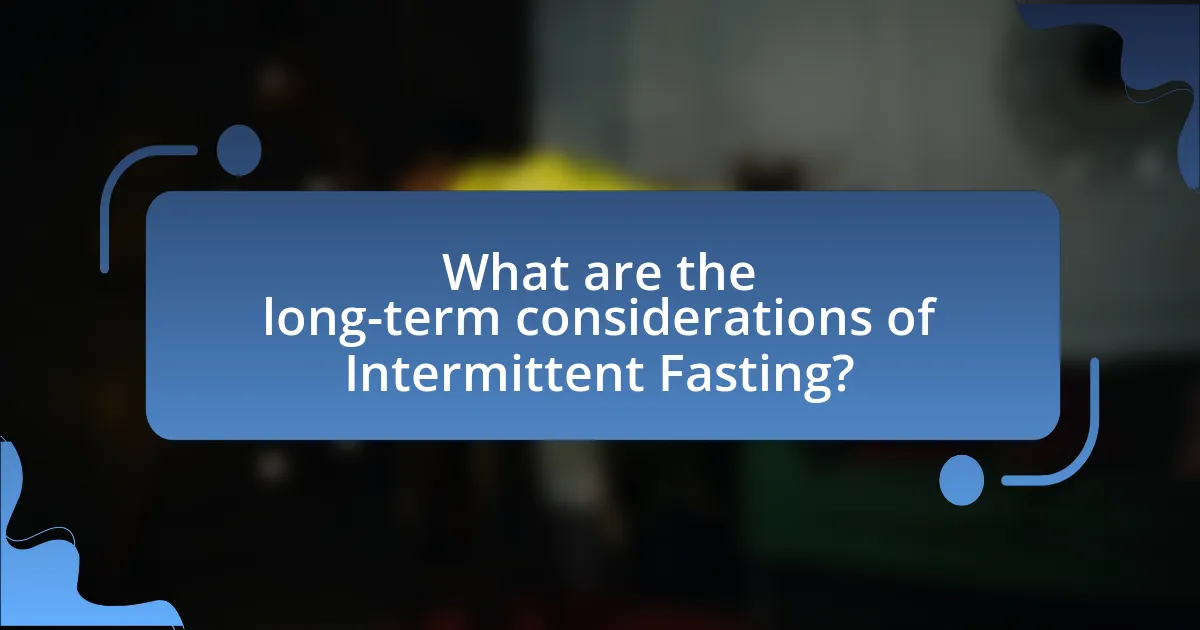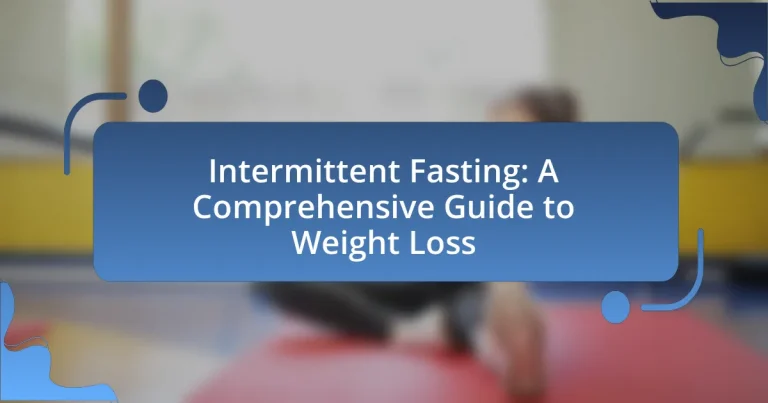Intermittent fasting is an eating pattern that alternates between periods of fasting and eating, with various methods such as the 16/8 method and the 5:2 diet. This approach focuses on when to eat rather than specific food choices, leading to potential benefits including weight loss, improved metabolic health, and enhanced brain function. The article explores how intermittent fasting works, its physiological effects on the body during fasting periods, and the different methods available. It also addresses common misconceptions, potential risks, and strategies for effectively implementing intermittent fasting, while emphasizing the importance of a balanced diet and lifestyle changes to support overall health.

What is Intermittent Fasting?
Intermittent fasting is an eating pattern that alternates between periods of fasting and eating. This approach does not prescribe specific foods but focuses on when to eat, with common methods including the 16/8 method, where individuals fast for 16 hours and eat during an 8-hour window. Research indicates that intermittent fasting can lead to weight loss, improved metabolic health, and potential benefits for longevity, as evidenced by studies such as those published in the New England Journal of Medicine, which highlight its effects on weight management and metabolic markers.
How does Intermittent Fasting work?
Intermittent fasting works by cycling between periods of eating and fasting, which alters the body’s metabolic state. During fasting periods, insulin levels drop, facilitating fat breakdown for energy, while human growth hormone levels increase, promoting muscle gain and fat loss. Research indicates that intermittent fasting can enhance cellular repair processes and improve metabolic health, as evidenced by a study published in the New England Journal of Medicine, which highlights its potential benefits for weight loss and overall health.
What are the different methods of Intermittent Fasting?
The different methods of Intermittent Fasting include the 16/8 method, the 5:2 diet, alternate-day fasting, and the Eat-Stop-Eat approach. The 16/8 method involves fasting for 16 hours and eating during an 8-hour window, commonly practiced by skipping breakfast. The 5:2 diet allows normal eating for five days of the week while restricting calorie intake to about 500-600 calories on two non-consecutive days. Alternate-day fasting alternates between days of normal eating and days of fasting or very low-calorie intake. The Eat-Stop-Eat approach consists of fasting for a full 24 hours once or twice a week. These methods are supported by various studies indicating their effectiveness in weight loss and metabolic health improvements.
How does the body respond during fasting periods?
During fasting periods, the body undergoes several physiological changes to adapt to the lack of food intake. Initially, the body depletes glycogen stores in the liver and muscles, transitioning to fat as the primary energy source. This metabolic shift promotes fat oxidation, leading to weight loss. Additionally, fasting triggers hormonal changes, including increased levels of norepinephrine and growth hormone, which enhance fat breakdown and preserve muscle mass. Research indicates that intermittent fasting can improve insulin sensitivity and reduce inflammation, contributing to overall metabolic health. These responses are supported by studies such as those published in the journal “Cell Metabolism,” which demonstrate the benefits of fasting on metabolic regulation and weight management.
What are the potential benefits of Intermittent Fasting?
Intermittent fasting offers several potential benefits, including weight loss, improved metabolic health, and enhanced brain function. Research indicates that intermittent fasting can lead to a reduction in body weight and body fat percentage, primarily due to decreased calorie intake and increased fat oxidation. A study published in the New England Journal of Medicine highlights that intermittent fasting can improve insulin sensitivity, which is crucial for metabolic health. Additionally, animal studies have shown that intermittent fasting may promote brain health by enhancing neuroplasticity and reducing oxidative stress, as noted in research from the Journal of Neurochemistry. These benefits collectively contribute to the effectiveness of intermittent fasting as a strategy for weight loss and overall health improvement.
How does Intermittent Fasting aid in weight loss?
Intermittent Fasting aids in weight loss by creating a calorie deficit and enhancing metabolic processes. During fasting periods, the body shifts from using glucose for energy to utilizing stored fat, which promotes fat loss. Research indicates that intermittent fasting can lead to a reduction in body weight and body fat percentage; for instance, a study published in the New England Journal of Medicine found that intermittent fasting can result in a 3-8% weight loss over 3-24 weeks. Additionally, fasting improves insulin sensitivity, which helps the body utilize fat more effectively.
What other health benefits are associated with Intermittent Fasting?
Intermittent fasting is associated with several health benefits beyond weight loss, including improved metabolic health, enhanced brain function, and reduced inflammation. Research indicates that intermittent fasting can lead to better insulin sensitivity, which helps regulate blood sugar levels and may lower the risk of type 2 diabetes. A study published in the New England Journal of Medicine highlights that intermittent fasting can promote autophagy, a cellular repair process that removes damaged cells, potentially reducing the risk of neurodegenerative diseases. Additionally, evidence suggests that intermittent fasting may lower markers of inflammation, contributing to overall cardiovascular health.
What are the common misconceptions about Intermittent Fasting?
Common misconceptions about Intermittent Fasting include the belief that it leads to muscle loss, that it is a starvation diet, and that it is not sustainable long-term. Research indicates that when done correctly, Intermittent Fasting can preserve muscle mass while promoting fat loss, as evidenced by a study published in the Journal of Translational Medicine, which found that participants maintained muscle while losing fat during fasting periods. Additionally, many people think Intermittent Fasting is synonymous with extreme calorie restriction; however, it allows for flexibility in food choices during eating windows, making it more sustainable than traditional diets. Lastly, some assume that Intermittent Fasting is only effective for weight loss, but it has also been shown to improve metabolic health and reduce inflammation, as highlighted in a review in the New England Journal of Medicine.
Why do some people believe Intermittent Fasting is unhealthy?
Some people believe Intermittent Fasting is unhealthy due to concerns about potential negative effects on metabolism and overall health. Critics argue that prolonged fasting periods can lead to nutrient deficiencies, decreased energy levels, and increased stress on the body. Research indicates that extreme caloric restriction may negatively impact hormonal balance and metabolic rate, which can be detrimental in the long term. Additionally, individuals with certain medical conditions, such as diabetes or eating disorders, may experience adverse effects from fasting, further fueling the belief that Intermittent Fasting is not suitable for everyone.
How can misinformation about Intermittent Fasting be addressed?
Misinformation about Intermittent Fasting can be addressed through education and dissemination of accurate information from credible sources. Providing access to peer-reviewed studies, such as those published in the Journal of the Academy of Nutrition and Dietetics, can help clarify misconceptions. For instance, research by Varady et al. (2015) demonstrates the effectiveness of Intermittent Fasting for weight loss and metabolic health, countering myths that it is unhealthy or ineffective. Engaging healthcare professionals to communicate evidence-based guidelines can further enhance public understanding and reduce the spread of false information.

How can one effectively implement Intermittent Fasting?
To effectively implement Intermittent Fasting, one should choose a specific fasting schedule, such as the 16/8 method, where an individual fasts for 16 hours and eats during an 8-hour window. This approach allows the body to enter a state of ketosis, promoting fat burning and weight loss. Research indicates that Intermittent Fasting can lead to a reduction in body weight and improved metabolic health, as evidenced by a study published in the New England Journal of Medicine, which highlights its benefits for weight management and metabolic disease prevention. Additionally, maintaining hydration during fasting periods and focusing on nutrient-dense foods during eating windows can enhance the effectiveness of this dietary strategy.
What are the best practices for starting Intermittent Fasting?
The best practices for starting Intermittent Fasting include selecting a fasting schedule that suits your lifestyle, such as the 16/8 method, where you fast for 16 hours and eat during an 8-hour window. Gradually easing into fasting can help your body adjust; for example, start with a 12-hour fast and increase the duration over time. Staying hydrated during fasting periods is crucial, as water, herbal teas, and black coffee can help manage hunger. Additionally, focusing on nutrient-dense foods during eating windows, such as whole grains, lean proteins, and plenty of fruits and vegetables, supports overall health and satiety. Research indicates that these practices can enhance adherence to fasting and improve metabolic health, as shown in studies like those published in the New England Journal of Medicine, which highlight the benefits of structured fasting approaches.
How should one prepare for the transition to Intermittent Fasting?
To prepare for the transition to Intermittent Fasting, one should gradually adjust their eating schedule by shortening the eating window over several days. This method allows the body to adapt to longer fasting periods without causing excessive hunger or discomfort. Research indicates that a gradual approach can help mitigate potential side effects, such as fatigue or irritability, which are common when abruptly changing eating patterns. Additionally, staying hydrated and focusing on nutrient-dense foods during eating periods can support overall health and enhance the effectiveness of the fasting regimen.
What should be considered when choosing a fasting schedule?
When choosing a fasting schedule, individual lifestyle, health goals, and personal preferences should be considered. These factors influence the effectiveness and sustainability of the fasting approach. For instance, a person with a demanding work schedule may benefit from a time-restricted eating window that aligns with their daily routine, such as the 16/8 method, which involves fasting for 16 hours and eating during an 8-hour window. Additionally, health conditions like diabetes or eating disorders necessitate consulting a healthcare professional before starting any fasting regimen. Research indicates that adherence to a fasting schedule is crucial for weight loss success, as consistent patterns help regulate metabolism and appetite.
What challenges might arise during Intermittent Fasting?
Challenges during Intermittent Fasting include hunger, fatigue, and difficulty concentrating. Hunger can be particularly intense during the initial days as the body adjusts to a new eating schedule, often leading to irritability. Fatigue may occur due to reduced calorie intake, especially if nutrient-dense foods are not consumed during eating windows. Difficulty concentrating can arise from low energy levels and fluctuating blood sugar, which may affect cognitive function. Research indicates that these challenges are common, especially in the early stages of adopting intermittent fasting, as the body adapts to changes in eating patterns.
How can one overcome hunger and cravings while fasting?
To overcome hunger and cravings while fasting, one can stay hydrated by drinking water, herbal teas, or black coffee, as these can help suppress appetite. Research indicates that dehydration can often be mistaken for hunger, so maintaining fluid intake is crucial. Additionally, consuming high-fiber foods during eating windows can promote satiety, as fiber slows digestion and keeps you feeling full longer. Studies show that fiber-rich diets can reduce hunger levels and improve overall satisfaction with meals. Engaging in activities or distractions can also help manage cravings, as focusing on tasks can divert attention from hunger signals.
What strategies can help maintain motivation during fasting periods?
To maintain motivation during fasting periods, individuals can set clear goals and track their progress. Establishing specific, measurable objectives helps create a sense of purpose, while monitoring achievements reinforces commitment. Research indicates that goal-setting enhances motivation and adherence to dietary plans, as demonstrated in a study published in the Journal of Nutrition Education and Behavior, which found that participants who set goals were more likely to stick to their fasting regimen. Additionally, engaging in supportive communities or social groups can provide encouragement and accountability, further boosting motivation during fasting.
How can one track progress while practicing Intermittent Fasting?
To track progress while practicing Intermittent Fasting, individuals can monitor weight changes, body measurements, and overall health markers. Regularly weighing oneself weekly provides a clear indication of weight loss or gain, while measuring waist, hips, and other body parts can reveal changes in body composition. Additionally, keeping a food diary to log eating windows and food choices helps assess adherence to the fasting schedule. Research indicates that tracking these metrics can enhance accountability and motivation, leading to more successful outcomes in weight loss efforts associated with Intermittent Fasting.
What metrics should be monitored to assess weight loss success?
To assess weight loss success, key metrics include body weight, body composition, waist circumference, and dietary adherence. Body weight provides a direct measure of weight loss progress, while body composition analysis, such as body fat percentage, offers insight into fat loss versus muscle loss. Waist circumference is crucial for evaluating abdominal fat, which is linked to health risks. Dietary adherence, measured through food logs or adherence rates, indicates how consistently one follows their weight loss plan. Monitoring these metrics can provide a comprehensive view of weight loss effectiveness and overall health improvements.
How can one adjust their approach based on progress?
To adjust one’s approach based on progress in intermittent fasting, individuals should regularly assess their weight loss results and overall health metrics. By tracking changes in body weight, energy levels, and hunger cues, one can determine if the current fasting schedule is effective or needs modification. For instance, if weight loss plateaus, it may be beneficial to alter the fasting window or caloric intake. Research indicates that personalized adjustments can enhance adherence and outcomes in weight loss programs, as evidenced by a study published in the Journal of Nutrition, which found that tailored dietary strategies significantly improved participant results.

What are the long-term considerations of Intermittent Fasting?
Long-term considerations of Intermittent Fasting include potential metabolic adaptations, nutritional deficiencies, and psychological effects. Research indicates that prolonged fasting can lead to improved insulin sensitivity and weight management, but it may also result in nutrient shortfalls if not properly managed. A study published in the New England Journal of Medicine highlights that while intermittent fasting can enhance metabolic health, individuals must ensure adequate nutrient intake to avoid deficiencies. Additionally, psychological impacts such as increased preoccupation with food or disordered eating patterns can arise, as noted in a review in the journal Appetite. Therefore, while intermittent fasting can offer benefits, careful attention to nutrition and mental health is essential for sustainable practice.
How does Intermittent Fasting affect metabolism over time?
Intermittent fasting positively affects metabolism over time by enhancing metabolic flexibility and increasing fat oxidation. Research indicates that intermittent fasting can lead to improved insulin sensitivity, which allows the body to utilize glucose more effectively and promotes fat burning. A study published in the journal “Cell Metabolism” by Longo and Mattson (2014) found that intermittent fasting can increase the production of norepinephrine, a hormone that boosts metabolic rate by up to 14%. Additionally, prolonged fasting periods can stimulate autophagy, a process that helps in cellular repair and energy efficiency, further supporting metabolic health.
What are the potential risks of long-term Intermittent Fasting?
Long-term Intermittent Fasting can lead to several potential risks, including nutrient deficiencies, muscle loss, and metabolic slowdown. Nutrient deficiencies may occur due to reduced food intake, which can result in inadequate vitamins and minerals essential for health. Muscle loss is a concern as prolonged fasting can lead to the body breaking down muscle tissue for energy, particularly if protein intake is insufficient. Additionally, metabolic slowdown can happen as the body adapts to lower caloric intake, potentially making weight maintenance more challenging. Research indicates that these risks are particularly pronounced in individuals who do not carefully plan their diets during fasting periods, highlighting the importance of balanced nutrition even when practicing Intermittent Fasting.
How can one ensure a balanced diet while practicing Intermittent Fasting?
To ensure a balanced diet while practicing Intermittent Fasting, one should focus on nutrient-dense foods during eating windows. This includes incorporating a variety of fruits, vegetables, whole grains, lean proteins, and healthy fats to meet daily nutritional needs. Research indicates that a balanced intake of macronutrients and micronutrients is essential for overall health and can enhance the benefits of Intermittent Fasting, such as improved metabolic health and weight management. For instance, a study published in the journal “Nutrition Reviews” highlights that diets rich in whole foods can support weight loss and improve metabolic markers, reinforcing the importance of food quality during fasting periods.
What lifestyle changes complement Intermittent Fasting?
Regular exercise complements Intermittent Fasting by enhancing metabolic health and promoting fat loss. Engaging in physical activity, such as strength training or cardiovascular workouts, can increase the effectiveness of fasting by improving insulin sensitivity and supporting muscle preservation during weight loss. Research indicates that combining exercise with Intermittent Fasting can lead to greater reductions in body fat compared to dieting alone, as shown in a study published in the Journal of Translational Medicine, which found that participants who exercised while fasting experienced more significant weight loss and improved body composition. Additionally, maintaining adequate hydration and prioritizing sleep are crucial lifestyle changes that support the benefits of Intermittent Fasting, as proper hydration aids in metabolic processes and quality sleep is linked to better weight management and hormonal balance.
How does physical activity influence the effectiveness of Intermittent Fasting?
Physical activity enhances the effectiveness of Intermittent Fasting by increasing metabolic rate and promoting fat oxidation. Engaging in regular exercise during fasting periods can lead to greater fat loss and improved insulin sensitivity. Research indicates that combining physical activity with Intermittent Fasting can amplify weight loss results, as a study published in the Journal of Translational Medicine found that participants who exercised while following an Intermittent Fasting regimen lost more body fat compared to those who did not exercise. This synergy between physical activity and fasting optimizes the body’s ability to utilize stored fat for energy, thereby improving overall weight loss outcomes.
What role does hydration play during fasting periods?
Hydration plays a crucial role during fasting periods by maintaining bodily functions and preventing dehydration. During fasting, the body still requires water for processes such as digestion, circulation, and temperature regulation. Studies indicate that even mild dehydration can impair cognitive function and physical performance, which is particularly important during fasting when energy levels may already be low. Furthermore, adequate hydration can help manage hunger pangs, making it easier to adhere to fasting protocols.
What practical tips can enhance the Intermittent Fasting experience?
To enhance the Intermittent Fasting experience, individuals should focus on staying hydrated, planning meals in advance, and incorporating nutrient-dense foods during eating windows. Staying hydrated helps manage hunger and supports overall health, as water intake can reduce feelings of hunger and improve metabolic processes. Planning meals ensures that individuals consume balanced nutrition, which is crucial for maintaining energy levels and preventing overeating. Incorporating nutrient-dense foods, such as vegetables, lean proteins, and healthy fats, provides essential vitamins and minerals, supporting bodily functions and enhancing the fasting experience. These strategies are supported by research indicating that proper hydration and balanced nutrition can improve adherence to fasting protocols and overall well-being.
How can meal planning support Intermittent Fasting goals?
Meal planning supports Intermittent Fasting goals by ensuring that individuals consume nutrient-dense meals within their eating windows, which can enhance satiety and prevent overeating. By organizing meals in advance, individuals can strategically select foods that align with their dietary needs, making it easier to adhere to fasting schedules. Research indicates that structured meal planning can lead to better food choices and improved dietary adherence, which are crucial for achieving weight loss and health objectives associated with Intermittent Fasting.
What are some easy recipes for meals during eating windows?
Easy recipes for meals during eating windows include a quinoa salad, a vegetable stir-fry, and a grilled chicken wrap. Quinoa salad combines cooked quinoa, diced cucumbers, cherry tomatoes, and a lemon vinaigrette, providing a nutritious and filling option. A vegetable stir-fry can be made with a mix of bell peppers, broccoli, and carrots sautéed in olive oil and soy sauce, offering a quick and healthy meal. The grilled chicken wrap consists of grilled chicken breast, mixed greens, and hummus wrapped in a whole grain tortilla, delivering protein and fiber. These recipes are simple to prepare and align well with the principles of intermittent fasting, ensuring balanced nutrition during eating windows.


